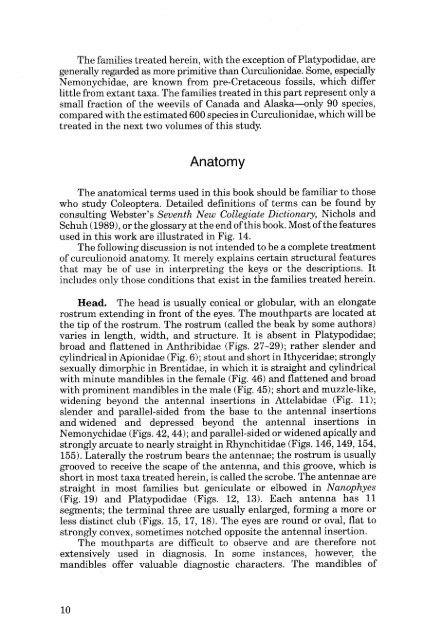Weevils - Entomological Society of Canada
Weevils - Entomological Society of Canada
Weevils - Entomological Society of Canada
You also want an ePaper? Increase the reach of your titles
YUMPU automatically turns print PDFs into web optimized ePapers that Google loves.
The families treated herein, with the exception <strong>of</strong> Platypodidae, are<br />
generally regarded as more primitive than Curculionidae. Some, especially<br />
Nemonychidae, are known from pre-Cretaceous fossils, which differ<br />
little from extant taxa. The families treated in this part represent only a<br />
small fraction <strong>of</strong> the weevils <strong>of</strong> <strong>Canada</strong> and Alaska-only 90 species,<br />
compared with the estimated 600 species in Curculionidae, which will be<br />
treated in the next two volumes <strong>of</strong> this study.<br />
Anatomy<br />
The anatomical terms used in this book should be familiar to those<br />
who study Coleoptera. Detailed defrnitions <strong>of</strong> terms can be found by<br />
consulting Webster's Seuenth New Collegiate Dictionory, Nichols and<br />
Schuh (1989), or the glossary at the end <strong>of</strong> this book. Most <strong>of</strong> the features<br />
used in this work are illustrated in Fig. 14.<br />
The following discussion is not intended to be a complete treatment<br />
<strong>of</strong> curculionoid anatomy. It merely explains certain structural features<br />
that may be <strong>of</strong> use in interpreting the keys or the descriptions. It<br />
includes only those conditions that exist in the families treated herein.<br />
Head. The head is usually conical or globular, with an elongate<br />
rostrum extending in front <strong>of</strong> the eyes. The mouthparts are located at<br />
the tip <strong>of</strong> the rostrum. The rostrum (called the beak by some authors)<br />
varies in length, width, and structure. It is absent in Platypodidae;<br />
broad and flattened in Anthribidae (Figs. 27-29); rather slender and<br />
cylindrical in Apionidae (Fig. 6); stout and short in Ithyceridae; strongly<br />
sexually dimorphic in Brentidae, in which it is straight and cylindrical<br />
with minute mandibles in the female (Fig. a6) and flattened and broad<br />
with prominent mandibles in the male (Fig. 45); short and muzzle-like,<br />
widening beyond the antennal insertions in Attelabidae (Fig. 11);<br />
slender and parallel-sided from the base to the antennal insertions<br />
and widened and depressed beyond the antennal insertions in<br />
Nemonychidae (Figs. 42,44); and parallel-sided or widened apically and<br />
strongly arcuate to nearly straight in Rhynchitidae (Figs. 146,I49,I54,<br />
155). Laterally the rostrum bears the antennae; the rostrum is usually<br />
grooved to receive the scape <strong>of</strong>the antenna, and this groove, which is<br />
short in most taxa treated herein, is called the scrobe. The antennae are<br />
straight in most families but geniculate or elbowed in Nanophyes<br />
(Fig. 19) and Platypodidae (Figs. \2, L3). Each antenna has 11<br />
segments; the terminal three are usually enlarged, forming a more or<br />
less distinct club (Figs. L5,17,18). The eyes are round or oval, flat to<br />
strongly convex, sometimes notched opposite the antennal insertion.<br />
The mouthparts are difficult to observe and are therefore not<br />
extensively used in diagnosis. In some instances, however, the<br />
mandibles <strong>of</strong>fer valuable diasnostic characters. The mandibles <strong>of</strong><br />
10

















